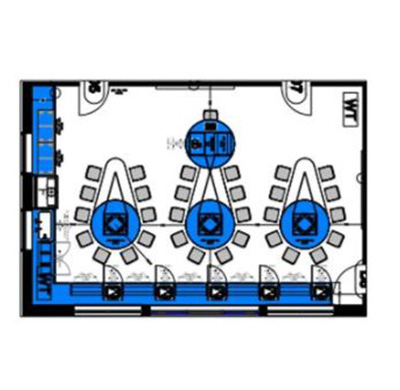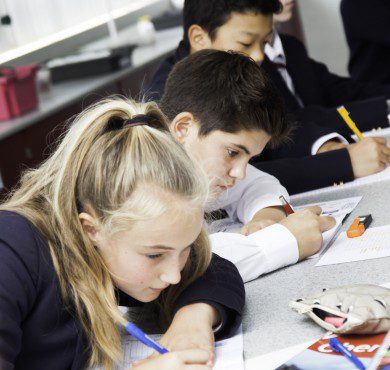Why the Relationship between Pedagogy and Design is important
What is pedagogy?
The word “pedagogy” is used a lot in the education sector but what does it mean?
Pedagogy is described as the science and art of education. As you can see from the triangle below that there are many factors that contribute to the learning environment.
A study by the National Training Laboratories found that the more active the teaching and learning methods, the higher the retention rates.—Adapted from The Learning Triangle: National Training Laboratories © mindServegroup 2005
If we take into consideration the range of learning methods students can engage within a classroom environment, then the more active ones are the most effective in increasing engagement. The shift in this type of learning focuses more on the student than the teacher – flipping the classroom
But how can pedagogy be affected by design, lesson plans and classroom size? In this article we will discuss the ways in which interior design can influence the creation of engaging education interiors.
Designing with Pedagogy in mind
According to the University of Salford ‘Clever Classrooms Report’, 2015, a well designed classroom can boost learning progress in students by up to 16%.
“Learning is not a spectator sport…[Students] must talk about what they are learning, write about it, relate it to past experiences, apply it to their daily lives. They must make what they learn part of themselves.”-Chickering and Gamson
The above statement supports the learning triangle diagram and ultimately practical and collaborative learning should be a key focus when creating an educational environment.
As a leading interior specialist, Innova worked with Architects Steer Design to create a laboratory for Mendip Studio School, specialising in Bioscience, Electronic Engineering, Computing and Maths. As part of the initial consultation it was important to keep the teaching methods at the heart of the design process.
The final room below addresses some of the key active features of the learning pyramid including collaboration, practice through practical’s, group discussions as well as encouraging independent learning – classrooms that are engaging, help to develop life skills and prepare students for the world of work.
Storage was also a key feature in this particular laboratory, especially with more practical work being carried out and the need to minimise clutter and hazards in the room: equipment, student bags and coats, books etc. Increased storage also allows the teacher to utilise the work spaces more efficiently and can reduce practical set up and clean up time.
The impact of classroom design and what effects it can have on teaching
With a record number of primary school classrooms filling up, Government statistics have revealed that the proportion of pupils in classes of 31 or more have increased over the last four years, from 11.4% in 2012 to 12.2% in 2016. This means that secondary schools and higher education will need to accommodate students in larger classrooms or in new builds, or else the standard of learning will suffer.
Building designs can create an impression or be symbolic of the type of learning environment likely to be experienced, so room layouts should be co-ordinated by the teacher’s lesson plans and structured according to the maximum number students per classroom.
Below is an example of Cronton’s Sixth Form Health & Fitness Lab, one of the UK’s first STEM buildings – The Idea Centre, which was created as part of their £9million investment. A state-of-the-art building designed to inspire and engage young students to develop skills in their chosen subject ready for their future careers.
From the storage facilities under the desks, to the ‘hot corner’ inspired benching, this classroom has enough space to support individual learning and group development activities, shortening the lines of communication between student and teacher.
According to Arthur W. Chickering and Zelda F. Gamson (1987) “Seven principles for good practice in undergraduate education” the six most powerful forces in education are;
- Activity
- Expectations
- Cooperation
- Interaction
- Diversity
- Responsibility
Having adaptable and flexible work spaces throughout a design plan can help strengthen the relationship between the interior and pedagogy of the classroom. An important factor when lesson planning and steering designers into creating highly engaging spaces; layout, furniture, storage, flexibility to adapt, all play a vital part.
If active and collaborative learning in teaching has proven to be effective, then why do some classrooms still fail to adapt to these methods? From fixed desks to “soldiers in a row” seating, why can’t mobile furniture and pear shaped seating be incorporated to help support kinetic teaching and dynamic learning? If done right the added benefits would be:
- Improvement of timetable efficiency
- Increase in more students per classroom
- Evolve teaching styles that include engaging practical’s
- Increase storage space that de-clutter the classroom, minimises distraction and hazards
- Allow ample circulation space for the teacher to observe, direct and guide students throughout lessons.
Conclusion
“Among the many methods employed to foster student development, the use of the physical environment is perhaps the least understood and the most neglected.”
-Banning and Conrad (1986)
Equipping the next generation of students to engage in the challenges that they’ll face in future society will not be met by a classroom that operates in isolation and conformity. Educating and inspiring students creatively requires a learning environment that can be flexible and collaborative, reflecting the way in which teachers relate to students and students relate to each other. This shift has already begun to reform the way we design the modern day classroom.
Contact
At Innova Design Group we specialise in designing, manufacturing and installing inspirational spaces, for further information contact us; 0161 477 5300, or email us at hello@innovadesigngroup.co.uk











